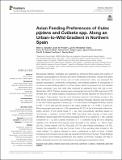Por favor, use este identificador para citar o enlazar a este item:
http://hdl.handle.net/10261/221266COMPARTIR / EXPORTAR:
 SHARE SHARE
 CORE
BASE CORE
BASE
|
|
| Visualizar otros formatos: MARC | Dublin Core | RDF | ORE | MODS | METS | DIDL | DATACITE | |

| Título: | Avian Feeding Preferences of Culex pipiens and Culiseta spp. Along an Urban-to-Wild Gradient in Northern Spain |
Autor: | González, Mikel A.; Prosser, Sean W.; Hernández-Triana, Luis M.; Alarcón-Herbal, Pedro M.; Goiri, Fatima; López Romero, Sergio CSIC ORCID; Ruiz-Arrondo, Ignacio; Hebert, Paul D. N.; García-Pérez, Ana N. | Palabras clave: | Culex pipiens Culiseta Blood meals Avian hosts Cytochrome c oxidase I Biodiversity Urban-wild gradient |
Fecha de publicación: | 15-oct-2020 | Editor: | Frontiers Media | Citación: | Frontiers in Ecology and Evolution 8: 568835 (2020) | Resumen: | Mosquitoes (Diptera: Culicidae) are regarded as annoying biting pests and vectors of disease-causing agents to humans and other vertebrates worldwide. Factors that affect their distribution and host choice are not well understood. Here, we assessed the species abundance, community composition, and feeding patterns of mosquitoes in an urban-to-wild habitat gradient in northern Spain. Adult mosquitoes from four habitats (urban, periurban, rural, and wild) were collected by aspiration from mid-July to mid-September, 2019. Thirteen species were represented among the 268 specimens (132 females and 136 males) trapped, including six new records reported for the first time in the region. Culex pipiens was the most abundant species in all habitats except in the wild, where Culex territans was dominant. The highest mosquito diversity was recorded in the wild habitat [species richness (S) = 10 and Shannon/Margalef-Diversity Indices (H’/MI = 1.51/1.36)] and the lowest in the urban habitat (S = 3; H’/MI = 0.24/0.41). Blood-engorged specimens (n = 65) represented 49.2% of the total female collections. Eighty percent of the blood-meals (n = 52) were successfully identified based on cytochrome c oxidase I subunit (COI) DNA barcoding. Nine species of birds were identified in blood meals from the three ecological forms of Cx. pipiens (n = 48), Culiseta fumipennis (n = 3), and Culiseta morsitans (n = 1) collected along the four sampling habitats. Four dominant bird species were recorded in Cx. pipiens, i.e., Parus major (35.4%), Turdus merula (18.7%), Pica pica (18.7%), and Passer domesticus (10.4%). Despite the availability of dog and human hosts in the sampling sites located in the urban habitat, Cx. pipiens seemed to have a preference to feed on birds. Culiseta fumipennis blood-meal host records are reported for first time in Europe. These findings on mosquito blood-feeding preferences and habitat community changes will help to better understand vector-host associations and pathogen transmission paths. | Versión del editor: | https://doi.org/10.3389/fevo.2020.568835 | URI: | http://hdl.handle.net/10261/221266 | DOI: | 10.3389/fevo.2020.568835 |
| Aparece en las colecciones: | (IQAC) Artículos |
Ficheros en este ítem:
| Fichero | Descripción | Tamaño | Formato | |
|---|---|---|---|---|
| fevo-08-568835.pdf | Artículo principal | 1,64 MB | Adobe PDF |  Visualizar/Abrir |
| 5175581.zip | Material suplementario | 29,08 kB | Unknown | Visualizar/Abrir |
CORE Recommender
SCOPUSTM
Citations
23
checked on 22-abr-2024
WEB OF SCIENCETM
Citations
22
checked on 28-feb-2024
Page view(s)
231
checked on 11-may-2024
Download(s)
201
checked on 11-may-2024
Google ScholarTM
Check
Altmetric
Altmetric
NOTA: Los ítems de Digital.CSIC están protegidos por copyright, con todos los derechos reservados, a menos que se indique lo contrario.


